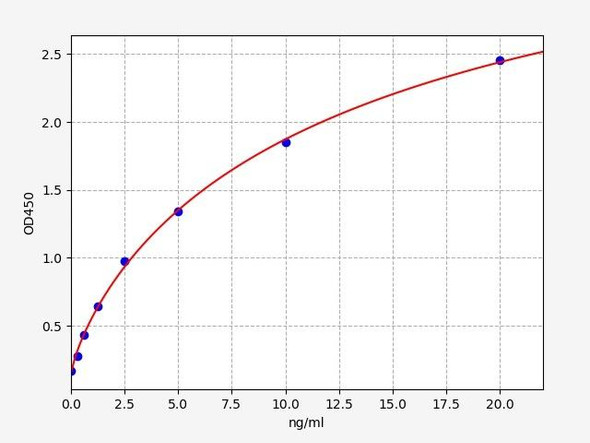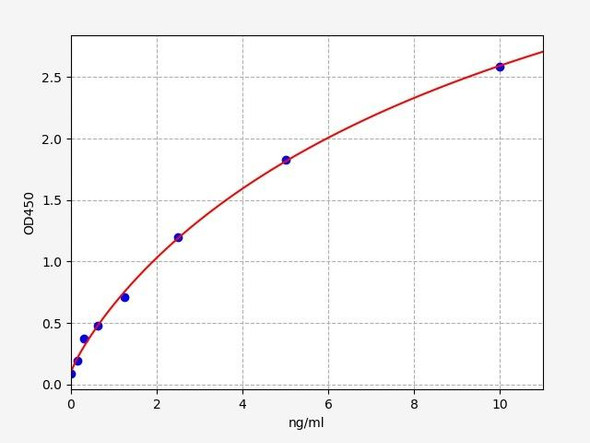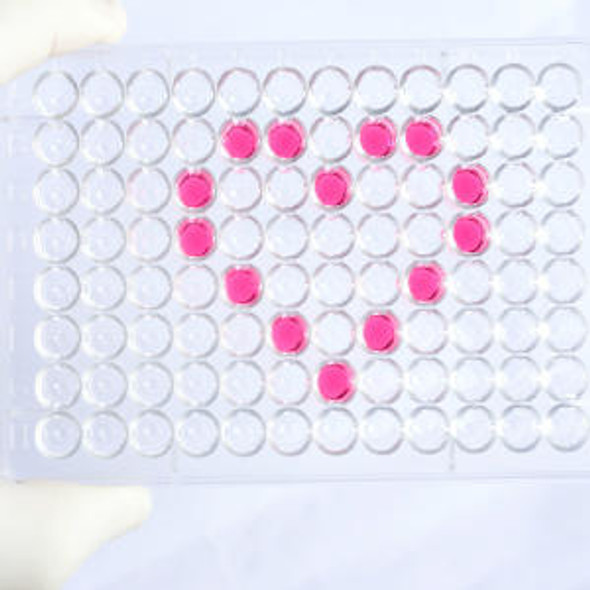Rat Receptor tyrosine-protein kinase erbB-3 (Erbb3) ELISA Kit
- SKU:
- RTEB1650
- Product Type:
- ELISA Kit
- Size:
- 96 Assays
- Uniprot:
- Q62799
- ELISA Type:
- Sandwich
- Reactivity:
- Rat
Description
| Product Name: | Rat Receptor tyrosine-protein kinase erbB-3 (Erbb3) ELISA Kit |
| Product Code: | RTEB1650 |
| Alias: | Receptor tyrosine-protein kinase erbB-3, Proto-oncogene-like protein c-ErbB-3, Erbb3, 2.7.10.1 |
| Uniprot: | Q62799 |
| Reactivity: | Rat |
| Range: | Please contact us for more information |
| Detection Method: | Sandwich |
| Size: | 96 Assay |
| Storage: | Please see kit components below for exact storage details |
| Note: | For research use only |
| UniProt Protein Function: | HER3: a receptor tyrosine kinase of the EGFR family. Binds and is activated by neuregulins and NTAK. Can form homodimers or ErbB-2/ErbB-3 heterodimers. Kinase domain lacks activity but heterodimerizes with other EGFRs to transduce growth signals. May be required for HER2 activity. Elevated expression in breast and other tumors is indicative of poor outcome. A secreted form is expressed in metastatic prostate cancer Two alternatively spliced isoforms have been described.Protein type: Oncoprotein; Kinase, protein; Protein kinase, tyrosine (receptor); Protein kinase, TK; Membrane protein, integral; EC 2.7.10.1; TK group; EGFR familyChromosomal Location of Human Ortholog: 12q13Cellular Component: extracellular space; basolateral plasma membrane; integral to plasma membrane; apical plasma membrane; plasma membrane; receptor complex; lateral plasma membraneMolecular Function: identical protein binding; protein binding; transmembrane receptor activity; protein homodimerization activity; protein heterodimerization activity; protein-tyrosine kinase activity; growth factor binding; protein tyrosine kinase activator activity; ATP bindingBiological Process: epidermal growth factor receptor signaling pathway; phosphoinositide 3-kinase cascade; fibroblast growth factor receptor signaling pathway; phosphoinositide-mediated signaling; nerve growth factor receptor signaling pathway; wound healing; heart development; cranial nerve development; negative regulation of cell adhesion; signal transduction; protein amino acid phosphorylation; peripheral nervous system development; negative regulation of signal transduction; regulation of cell proliferation; Schwann cell differentiation; positive regulation of phosphoinositide 3-kinase cascade; neuron apoptosis; innate immune response; negative regulation of secretion; negative regulation of neuron apoptosis; transmembrane receptor protein tyrosine kinase signaling pathwayDisease: Lethal Congenital Contracture Syndrome 2 |
| UniProt Protein Details: | |
| NCBI Summary: | This gene encodes a member of the epidermal growth factor receptor (EGFR) family of receptor tyrosine kinases. This membrane-bound protein has a neuregulin binding domain but not an active kinase domain. It therefore can bind this ligand but not convey the signal into the cell through protein phosphorylation. However, it does form heterodimers with other EGF receptor family members which do have kinase activity. Heterodimerization leads to the activation of pathways which lead to cell proliferation or differentiation. Amplification of this gene and/or overexpression of its protein have been reported in numerous cancers, including prostate, bladder, and breast tumors. Alternate transcriptional splice variants encoding different isoforms have been characterized. One isoform lacks the intermembrane region and is secreted outside the cell. This form acts to modulate the activity of the membrane-bound form. Additional splice variants have also been reported, but they have not been thoroughly characterized. [provided by RefSeq, Jul 2008] |
| UniProt Code: | Q62799 |
| NCBI GenInfo Identifier: | 54792102 |
| NCBI Gene ID: | 2065 |
| NCBI Accession: | NP_001005915.1 |
| UniProt Secondary Accession: | Q62799,Q61526, Q62799 |
| UniProt Related Accession: | Q62799,P21860 |
| Molecular Weight: | 148,098 Da |
| NCBI Full Name: | receptor tyrosine-protein kinase erbB-3 isoform s |
| NCBI Synonym Full Names: | v-erb-b2 erythroblastic leukemia viral oncogene homolog 3 (avian) |
| NCBI Official Symbol: | ERBB3 |
| NCBI Official Synonym Symbols: | HER3; LCCS2; ErbB-3; c-erbB3; erbB3-S; MDA-BF-1; c-erbB-3; p180-ErbB3; p45-sErbB3; p85-sErbB3 |
| NCBI Protein Information: | receptor tyrosine-protein kinase erbB-3; proto-oncogene-like protein c-ErbB-3; tyrosine kinase-type cell surface receptor HER3 |
| UniProt Protein Name: | Receptor tyrosine-protein kinase erbB-3 |
| UniProt Synonym Protein Names: | Proto-oncogene-like protein c-ErbB-3; Tyrosine kinase-type cell surface receptor HER3 |
| Protein Family: | |
| UniProt Gene Name: | ERBB3 |
| UniProt Entry Name: | ERBB3_HUMAN |
| Component | Quantity (96 Assays) | Storage |
| ELISA Microplate (Dismountable) | 8×12 strips | -20°C |
| Lyophilized Standard | 2 | -20°C |
| Sample Diluent | 20ml | -20°C |
| Assay Diluent A | 10mL | -20°C |
| Assay Diluent B | 10mL | -20°C |
| Detection Reagent A | 120µL | -20°C |
| Detection Reagent B | 120µL | -20°C |
| Wash Buffer | 30mL | 4°C |
| Substrate | 10mL | 4°C |
| Stop Solution | 10mL | 4°C |
| Plate Sealer | 5 | - |
Other materials and equipment required:
- Microplate reader with 450 nm wavelength filter
- Multichannel Pipette, Pipette, microcentrifuge tubes and disposable pipette tips
- Incubator
- Deionized or distilled water
- Absorbent paper
- Buffer resevoir
*Note: The below protocol is a sample protocol. Protocols are specific to each batch/lot. For the correct instructions please follow the protocol included in your kit.
Allow all reagents to reach room temperature (Please do not dissolve the reagents at 37°C directly). All the reagents should be mixed thoroughly by gently swirling before pipetting. Avoid foaming. Keep appropriate numbers of strips for 1 experiment and remove extra strips from microtiter plate. Removed strips should be resealed and stored at -20°C until the kits expiry date. Prepare all reagents, working standards and samples as directed in the previous sections. Please predict the concentration before assaying. If values for these are not within the range of the standard curve, users must determine the optimal sample dilutions for their experiments. We recommend running all samples in duplicate.
| Step | |
| 1. | Add Sample: Add 100µL of Standard, Blank, or Sample per well. The blank well is added with Sample diluent. Solutions are added to the bottom of micro ELISA plate well, avoid inside wall touching and foaming as possible. Mix it gently. Cover the plate with sealer we provided. Incubate for 120 minutes at 37°C. |
| 2. | Remove the liquid from each well, don't wash. Add 100µL of Detection Reagent A working solution to each well. Cover with the Plate sealer. Gently tap the plate to ensure thorough mixing. Incubate for 1 hour at 37°C. Note: if Detection Reagent A appears cloudy warm to room temperature until solution is uniform. |
| 3. | Aspirate each well and wash, repeating the process three times. Wash by filling each well with Wash Buffer (approximately 400µL) (a squirt bottle, multi-channel pipette,manifold dispenser or automated washer are needed). Complete removal of liquid at each step is essential. After the last wash, completely remove remaining Wash Buffer by aspirating or decanting. Invert the plate and pat it against thick clean absorbent paper. |
| 4. | Add 100µL of Detection Reagent B working solution to each well. Cover with the Plate sealer. Incubate for 60 minutes at 37°C. |
| 5. | Repeat the wash process for five times as conducted in step 3. |
| 6. | Add 90µL of Substrate Solution to each well. Cover with a new Plate sealer and incubate for 10-20 minutes at 37°C. Protect the plate from light. The reaction time can be shortened or extended according to the actual color change, but this should not exceed more than 30 minutes. When apparent gradient appears in standard wells, user should terminatethe reaction. |
| 7. | Add 50µL of Stop Solution to each well. If color change does not appear uniform, gently tap the plate to ensure thorough mixing. |
| 8. | Determine the optical density (OD value) of each well at once, using a micro-plate reader set to 450 nm. User should open the micro-plate reader in advance, preheat the instrument, and set the testing parameters. |
| 9. | After experiment, store all reagents according to the specified storage temperature respectively until their expiry. |
When carrying out an ELISA assay it is important to prepare your samples in order to achieve the best possible results. Below we have a list of procedures for the preparation of samples for different sample types.
| Sample Type | Protocol |
| Serum | If using serum separator tubes, allow samples to clot for 30 minutes at room temperature. Centrifuge for 10 minutes at 1,000x g. Collect the serum fraction and assay promptly or aliquot and store the samples at -80°C. Avoid multiple freeze-thaw cycles. If serum separator tubes are not being used, allow samples to clot overnight at 2-8°C. Centrifuge for 10 minutes at 1,000x g. Remove serum and assay promptly or aliquot and store the samples at -80°C. Avoid multiple freeze-thaw cycles. |
| Plasma | Collect plasma using EDTA or heparin as an anticoagulant. Centrifuge samples at 4°C for 15 mins at 1000 × g within 30 mins of collection. Collect the plasma fraction and assay promptly or aliquot and store the samples at -80°C. Avoid multiple freeze-thaw cycles. Note: Over haemolysed samples are not suitable for use with this kit. |
| Urine & Cerebrospinal Fluid | Collect the urine (mid-stream) in a sterile container, centrifuge for 20 mins at 2000-3000 rpm. Remove supernatant and assay immediately. If any precipitation is detected, repeat the centrifugation step. A similar protocol can be used for cerebrospinal fluid. |
| Cell culture supernatant | Collect the cell culture media by pipette, followed by centrifugation at 4°C for 20 mins at 1500 rpm. Collect the clear supernatant and assay immediately. |
| Cell lysates | Solubilize cells in lysis buffer and allow to sit on ice for 30 minutes. Centrifuge tubes at 14,000 x g for 5 minutes to remove insoluble material. Aliquot the supernatant into a new tube and discard the remaining whole cell extract. Quantify total protein concentration using a total protein assay. Assay immediately or aliquot and store at ≤ -20 °C. |
| Tissue homogenates | The preparation of tissue homogenates will vary depending upon tissue type. Rinse tissue with 1X PBS to remove excess blood & homogenize in 20ml of 1X PBS (including protease inhibitors) and store overnight at ≤ -20°C. Two freeze-thaw cycles are required to break the cell membranes. To further disrupt the cell membranes you can sonicate the samples. Centrifuge homogenates for 5 mins at 5000xg. Remove the supernatant and assay immediately or aliquot and store at -20°C or -80°C. |
| Tissue lysates | Rinse tissue with PBS, cut into 1-2 mm pieces, and homogenize with a tissue homogenizer in PBS. Add an equal volume of RIPA buffer containing protease inhibitors and lyse tissues at room temperature for 30 minutes with gentle agitation. Centrifuge to remove debris. Quantify total protein concentration using a total protein assay. Assay immediately or aliquot and store at ≤ -20 °C. |
| Breast Milk | Collect milk samples and centrifuge at 10,000 x g for 60 min at 4°C. Aliquot the supernatant and assay. For long term use, store samples at -80°C. Minimize freeze/thaw cycles. |










